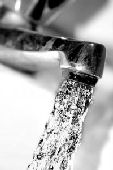
Purpose
To demonstrate how oppositely charged electrons can be used to bend water.
Additional information
Static electricity is the accumulation of excess electric charge where there exists poor electrical conductivity. Every day we interact and observe the effects of static electricity from multiple sources, none more so than the static created by our own bodies. When we brush our hair, rub our feet on the ground, or pull a wool sweater over our heads, excess electrons are created and cling to our body until they can be discharged. This phenomena occurs because all physical objects are made up of charges, which in turn are made from atoms consisting of protons (positive charges), electrons (negative charges), and neutrons (neutral). When a sustained separation of positive and negative charges occurs, static electricity is formed.
Sponsored Links
Required materials
- Water faucet with running water
- Latex balloon
- Nylon comb
Estimated Experiment Time
Only a few minutes
Step-By-Step Procedure
- 1. Inflate the nylon balloon.
- 2. Turn on the faucet so that the water is coming out at a slow and steady stream. It's usually best to use a bathroom sink faucet as the nozzle can produce smooth jets of water at low output.
- 3. Take the inflated balloon and rub it against the nylon comb to create a static charge on the comb.
- 4. Slowly and carefully place the teeth of your charged comb next to the stream of water. As your comb gets closer, the water stream reacts by bending towards your comb!
Note
If you don't have a latex balloon, you can try charging the comb through other methods, such as brushing your hair or rubbing it against a wooly sweater. The key is to give the comb a charge of static electricity so it can cause the water to react.
Observation
How does humidity affect the outcome of the experiment? Do you think the same result would occur in an atmosphere of high humidity as it would in an atmosphere of low humidity? Do you think the material used would make a difference in the strength of the negative charge on the comb? What if the comb or the faucet nozzle were larger in size, would the experiment result in the same outcome?
Result
The stream of water running from the faucet actually carries a positive electrical charge. When the comb is rubbed against the balloon (charged) electrons form to create a negative charge on the comb. Much like magnets, the negative charge on the comb is attracted to the positive charge of the running water. When the charge is strong enough, it will pull the running water towards the comb, allowing you to bend water!
It's important to note that this experiment is best conducted in low humidity environments. When humidity is high, the atmosphere provides a conducting path for the rapid neutralization of static charge, causing the effectiveness to be greatly reduced.
Sponsored Links
Take a moment to visit our table of Periodic Elements page where you can get an in-depth view of all the elements,
complete with the industry first side-by-side element comparisons!